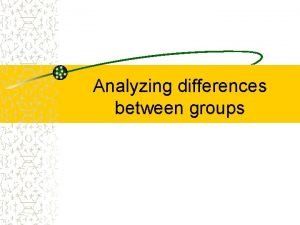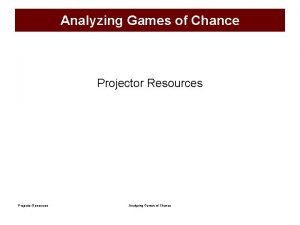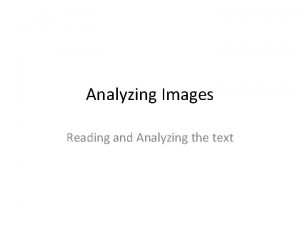Concept Development MODEL The Concept Development Model Analyzing









- Slides: 9

Concept Development MODEL

The Concept Development Model Analyzing Relationships Between Parts of A Concept by Hilda Taba (1966) used to enhance thinking skills of students. It gives students practice in categorizing, and developing, extending and refining concepts Process Step Teacher Student Listing Teacher or students lists items related to a subject Tell me what you see List specific items Grouping Students group the items Do any of these items belong together? Finds similarity as a basis for grouping items Labeling Students gives label for the newly defined groups. Students explain reason for their choices. What would you call these groups you have formed? Verbalizes a label(s) that encompasses all items Identifies and verbalizes common characteristics of items in a group Regrouping (optional) Students regroup items or subsume individual items or whole groups Could some of these belong to more than one group? Can we put these same items in different groups? Why would you group them that way? States different relationships States additional different relationships Evaluating or Synthesizing Students synthesize the information by summarizing the data and forming generalizations Can someone say in one sentence something about all these groups? Offers a summary statement and/or questions • www. math. ccsu. edu/mitchell/mat 520 conceptdevelopmentmodel. ppt Tell me what you know Why would you group them together?

A COGNITIVE TEMPLATE/MAP FOR A CONCEPT DEVELOPMENT LESSON PURPOSE OF DISCUSSION: TO EXTEND AND CLARIFY THE STUDENTS CONCEPT OF HUMAN DEPENDENCE ON NATURE

Behavioral Objectives Focus Questions ▪Student oriented ▪Open-ended ▪States what the student is expected to do ▪Guides the learner ▪Uses statements ▪Creates original thinking about an issue ▪Uses inquiry

Step 1 (Listing) Behavioral Objectives Generate examples and nonexamples based from your own understanding and experiences. Focus Questions What are examples of food that come from nature? Brainstorm examples and nonexamples Type Your Answers Below + - List at least 15 examples. List 5 -6 non-examples. 1. Apples 2. Steak 3. Peaches 4. Raisins 5. Pineapples 6. Pears 7. Ham 8. Green beans 9. Carrots 10. Celery 11. Rice 12. Corn 13. Tomatoes 14. Chicken 15. Shrimp 16. Milk 17. Plums 18. Cheese 19. Yogurt 20. Oatmeal 1. Aspirin 2. Cleaning oils 3. Processed margarine 4. Poisonous apple 5. Magical beans

Step 2 (Grouping and Labeling) Behavioral Objectives Focus Questions Group words that are similar. After you have grouped the words, label the categories. Group these in the boxes to the right. (inductive learning) Think about what the words you brainstormed have in common. Group words that are alike and create a label for each category that you created. Note: You might not use all the words, and you may use some words twice if they fit into more than one category. Type Your Answers Below Fruits Apple Peaches Pineapples Pears Raisins Plum Vegetable Starch Green bean Rice Carrots Oatmeal Celery Corn Tomatoes From Animals Ham Chicken Steak Shrimp Dairy Cheese Milk Yogurt

Step 3 (Evaluating and Synthesizing) Generalizations Behavioral Objectives Write generalizations. Type in the box to the right. Focus Questions Type Your Answers Below Humans depend on nature for food. Review your categories. Based on Nature provides a way to create food. our original list, the Protecting nature is necessary for nourishment. groups we’ve created, what would you conclude about the food we get from nature?

Step 4 (Evaluating and Synthesizing) Essential Questions Behavioral Objectives Focus Questions Create essential Refer to your questions. Type in generalizations and the box to the right. turn your statement into an open-ended questions. Type Your Answers Below Why are humans so dependent on nature for food? How do humans rely on our environment for nourishment? If we don’t take care of nature, how will we be what we eat?

Refer to Advancing Differentiation: Thinking and st Learning for the 21 Century p. 18 -19 (Model on Change) Lesson Plan referenced from Gallagher, Shelagh. "Concept Development: A Hilda Taba Teaching Strategy. " 2012.

















